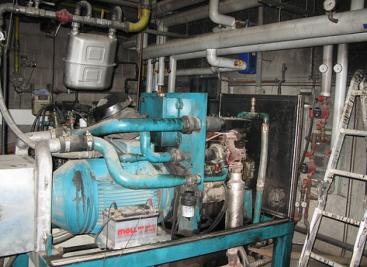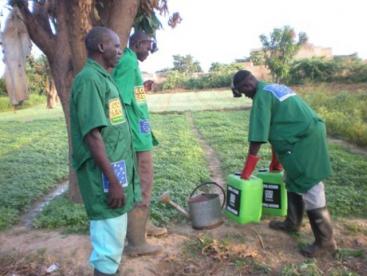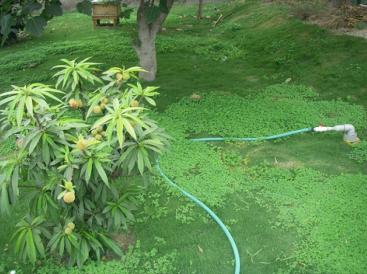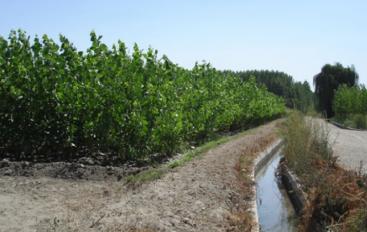Greenhouse Effect and Responsible Gases
The greenhouse effect is the phenomenon where the presence of so-called greenhouse gases leads to a warming of the earth's surface: Greenhouse gases allow solar radiation to enter the earth's atmosphere but prevent heat from escaping back to space. They absorb infrared radiation and reflect it to the earth's surface leading to a warming there. Many human activities cause greenhouse gas emissions which drive the anthropogenic greenhouse effect. According to the Intergovernmental Panel on Climate Change the atmospheric greenhouse effect will cause a rise in the mean global temperature of between 1.1 and 6.4°C by the end of the 21st century (IPCC 2007a), a change in rainfall patterns, a rising sea level and a weakening of sea currents which will have an additional impact on the global temperature distribution. In order to limit climate change to tolerable levels, global temperature rise has to be limited to 2°C (IPCC 2007b). To achieve this, greenhouse gas emissions would have to be reduced by 50% by 2050 compared to the level in 1990 (IPCC 2007c).
Relevant Greenhouse Gases
In the field of sanitation, the following greenhouse gases are climate relevant:
- Carbon dioxide (CO2)is produced as a result of any fossil or non-renewable wooden biomass combustion. Similarly, the removal of organics and nutrients in wastewater treatment plants requires energy. The same holds true for the production of mineral fertilisers which is a very energy intensive process. Both the removal and the new production of nutrients for fertilisers require the consumption of fossil fuels leading directly to climate relevant CO2 emissions. For climate protection, it is important to reduce fossil or non-renewable wooden biomass consumption.
- Methane (CH4) is a potent greenhouse gas with a global warming potential 21 times higher than that of CO2. In anaerobic processes, organic matter contained in domestic waste and wastewater is decomposed and biogas is formed which contains 60-70% methane. In soak pits, anaerobic ponds, septic tanks and other anaerobic treatment systems where biogas is either not collected or leaking (e.g. many UASB reactors), or even at the discharge of untreated wastewater into water bodies, anaerobic processes take place to different extents and methane is released to the atmosphere. For climate protection, wherever biogas is produced, it should be captured through a controlled anaerobic treatment and used as a renewable energy source. If the biogas cannot be used, then it has to be flared. As an alternative to a controlled anaerobic treatment, methane formation should be avoided through a low-energy aerobic treatment (e.g. dehydration, composting, constructed wetland).
- Nitrous oxide (N2O) is the most harmful greenhouse gas with a global warming potential 310 times higher than that of CO2. Nitrous oxide emissions occur during the denitrification process in wastewater treatment, at the disposal of nitrogenous wastewater into aquatic systems and also during mineral nitrogen fertiliser production. For climate protection, nitrogen should be recovered and reused as a fertiliser, or nitrogenous wastewater should be treated for the intended use and reused (e.g. for irrigation or groundwater recharge).
Mitigation and Adaptation in Sanitation

Biogas stove in kitchen used in India. Source: FULFORD (2008)

Combined heat and power (CHP) unit in Germany. Source: SUSANA (2009)
By using appropriate reuse-oriented sanitation systems with energy, nutrient or wastewater recovery and reuse, anthropogenic greenhouse gas emissions can be reduced (mitigation) as well as people's capacity to cope with climate change impacts can be increased (adaptation). In the field of sanitation, possible measures to mitigate or adapt to climate change impacts are described in the following sections about mitigation measures and adaptation measures.
Besides the avoidance of energy intensive aerobic treatment systems, sanitation systems can be operated in a way to produce renewable energy in the forms of either biogas or biomass and thus reduce the primary energy consumption:
- Biogas production or its avoidance (see below and section about biogas production).
- Biomass production (see section about biomass production).
Wherever biogas is produced, it must be captured and preferably used either for simple heat generation or for a combined heat and electricity generation, e.g. by means of a combined heat and power plant (see pictures below) or by a fuel cell. This can substitute the use of fossil or non-renewable energy sources. If the biogas cannot be used, then it has to be flared (this converts methane to carbon dioxide which has a 21 times lower greenhouse gas potential than methane, see section about relevant greenhouse gases). This results in the following recommendations:
- Where treatment size allows for it, replace existing (facultative) anaerobic ponds (also called "lagoons") and septic tanks by a controlled anaerobic treatment systems (e.g. biogas plant, UASB reactors, anaerobic baffled reactor).
- Design and build any new anaerobic treatment system as a closed gastight construction with biogas capture.
- Close existing open septic tanks as well as leaky biogas plants (e.g. anaerobic digesters, biogas settlers, UASB reactors , anaerobic baffled reactors, etc.) gastight and avoid venting by restoring the flares.
If neither the use nor the flare can be realised, uncontrolled biogas production should be avoided. Therefore, where septic tanks or biogas settlers are too small for a controlled anaerobic treatment (i.e. generally household level), aim at replacing septic tanks by appropriate, low-energy, (partially) aerobic treatment methods (e.g. dehydration, composting, constructed wetland).
Another possible measure is the heat recovery from:
- wastewater (e.g. from greywater or wastewater running in sewers or from the effluent of wastewater treatment plants) and its use.
- the heated pressurised air for the aeration of activated sludge tanks and its use.
Since these measures represent very local options for conventional centralised systems, they are not further discussed here.
Nutrient Recovery from Wastewater

Urine application in agriculture as seen in Burkina Faso. Source: FALL (2009)
The macro nutrients nitrogen (N), phosphorus (P) and potassium (K) contained in human and animal excreta can be locally recovered and safely used as fertiliser in agriculture (see also nutrient requirements of plants). In this way, they can substitute the energy intensive production of manufactured mineral fertilisers and their transport over long distances. Since N-fertilisers require more energy (REMY et al. 2006) and are consumed in larger amounts than P- and K-fertilisers (GELLINGS & PARMENTER 2004), it is sufficient to focus on nitrogen fertilisers only when considering energy demand and climate-relevant effects from fertilisers. Since 87% of the excreted nitrogen is contained in urine, from a climate protection point of view, concentrating on the recovery and reuse of the nitrogen contained in urine represents the most efficient means of emission reduction through nutrient recovery (see also urine fertilisation at small or large scale).
Therefore, artificial mineral fertilisers should be replaced by natural fertilisers (urine, sludge, dried faeces) as far as possible (see recharge and reuse for more information).
Adaptation Measures in Regard to Water

Garden irrigated with treated blackwater in Peru. Source: SUSANA (2009)

Energy plants cultivated in a short-rotation-plantation. Source: HAENEL (n.y.)
In order to adapt to water scarcity, the following measures should be taken into account (list is not exhaustive):
- Wastewater (esp. greywater), treated to the appropriate degree for the intended use ("reclaimed water"), or rainwater can be reused for the irrigation of food crops or lawns, or energy crops (see short rotation plantations or fertigation), parks and other public spaces, for groundwater recharge or as service water. In cases where potable water is used for irrigation, the use of treated wastewater substitutes the extraction, processing and distribution of potable water and thus may lead to energy savings. The main benefit however would lie in a reduced primary water resources demand. The nutrient content of the wastewater also reduces the need for mineral fertiliser input as mentioned. Further information on wastewater reuse in agriculture can be found in (WHO 2006).
- Reduce physical water losses through both the repair of leaking pipes and the introduction of a water pressure management of water pipe networks (see leakage control).
- Minimise virtual water losses by reducing the exportation of highly water consuming products (e.g. animal meat, cotton, rice) and increase the import of highly water consuming products (e.g. cereals) (see virtual water).
- Use dry toilet systems (especially in water scarce areas) for substituting waterborne sanitation systems. Toilets which don't require water for flushing, but can nevertheless be indoors (e.g. UDDTs, composting toilets), may save about 40 L/(cap · d) compared to conventional flush toilets.
- Install water collection and storage units (cisterns and underground reservoirs) providing water for drought periods (in regions with an intermittent water supply)
- Increase the cultivation of drought resistant crops.
- The irrigation methods used should minimise water losses through evaporation and infiltration (e.g. sub-surface irrigation).
- Seawater desalination plants might be installed if operated by renewable energies (e.g. Saharan solar power plants).
- See also optimisation of water use for further information.
- In order to adapt to flooding, one effective measure consists of building sanitation system components in a way that they are either not affected by flooding (UDDTs built high enough above ground) or that water can evacuate quickly (elevated sludge drying beds, constructed wetland).
Emission Trading as an Additional Financial Benefit
The Kyoto Protocol – the internationally binding contract on climate protection measures valid until the end of 2012 – assigns each participant country which has emission reduction commitments an allowed amount of greenhouse gas emissions. In order to reach this emission target at the least macro economic costs, the Kyoto Protocol offers three market-based flexible mechanisms. One of them, the Clean Development Mechanism (CDM), is designed for trading emission reductions which have been achieved in developing countries.
The CDM can be used for emission reductions achieved through sustainable sanitation systems. It can contribute to an additional financial benefit but also generates CDM-related costs which are mostly fixed and which compensate achieved credits to some extent.
Hence, for sustainable sanitation systems, a minimum project scale is required to make CDM economically attractive. This is very much dependent on both the baseline and the project scenario, the energy demand of the fertiliser production plants, the energy mix of the country considered, the transaction costs and the price of the carbon credits.
Assuming average transaction costs and a long-term price of 20 €/CER, the minimum project scale was found in (OLT 2008) to be around 25 000 PE1 (for energy recovery) and 37 000 PE (for nutrient recovery). The minimum project scale for an economic use of CDM for energy recovery (biogas use) and nutrient recovery (urine use) was analysed for a case study in India (OLT 2008). From an emission reduction point of view, this project faced favourable conditions in view of energy recovery and unfavourable conditions in view of nutrient recovery. Therefore the above indicated project scale for energy recovery represents an absolute minimum value, while the value for nutrient recovery can also be lower.
In order to reach this number, similar CDM projects may be bundled to a "Programme of Activities" (PoA). A manual for biogas plants at household level is given in (GFA 2009). Further information on PoA is available at (UNFCCC 2009).
Renewable Energy Production from Sanitation
Biogas production: Biogas is a renewable energy that can be used for cooking, lighting, heating purposes, and for generating electrical power. It is produced by bacteria that decompose organic matter under anaerobic conditions (i.e. in the absence of oxygen). The technology of anaerobic digestion has been applied to human and animal excreta for over 150 years. The anaerobic bacteria grow slowly and higher temperatures result in faster decomposition rates. For biogas generation various substrates can be used (often in combination of each other), e.g.
- blackwater, i.e. mixture of excreta and flushing water (best from low-flush or vacuum toilets)
- organic waste from households or agricultural farms
- animal manure
- sewage sludge originating from domestic wastewater
- human excreta from dry toilets
In many Asian countries, e.g. China, human excreta or so called "night soil" is being treated in this way together with animal manure and other organic waste. As a result of a Chinese national programme in the 1970s ("Biogas for every household"), the increasing energy demand and continuing efforts to combat wood cutting, there is an on-going interest in biogas which is supported by the Ministry of Agriculture. Today, there are five million family-sized plants in operation (BALASUBRAMANIYAM et al. 2008).
Biomass Production: Biomass is a non-fossil energy source which is neither always harmful nor always neutral to the climate. According to the UNFCCC definition (UNFCCC 2006), renewable biomass is understood as:
- wood (provided that wood harvest does not exceed its growth)
- other wooden biomass (provided that the cultivated area remains constant)
- animal or human manure
- solid organic waste (domestic or industrial)
Both food and biomass production are essential for people's livelihoods, and often compete with each other for available land, water and nutrient resources. Food and biomass production might be seen as equally important in economically rich countries with a safe food supply. But in many developing countries food production takes priority, whilst at the same time most people are dependent on biomass (particularly wood) for their energy supply, primarily to cook their food. One way to establish whether priorities should tend towards either food or biomass production is to carry out a national food balance taking into account food production and food consumption (OECD-FAO 2008). This can then be used as a basis for making decisions regarding the cultivation of more food or more energy crops. The use of sanitation-derived fertilisers in agriculture may increase the productivity of the land and thus decrease the conflict between food and biomass production at the local level (see also short rotation plantations).
Conclusion
It has been shown that sustainable sanitation projects can contribute to both mitigate climate change (through energy or nutrient recovery) and to adapt to climate change (through an intelligent water and wastewater management). Measures of energy recovery (or: renewable energy production) consist basically of either biogas or biomass production while measures of nutrient recovery are primarily based on nitrogen reuse. Water and wastewater management measures aim at coping with either water scarcity or flooding.
Most of these measures lead to greenhouse gas emission reductions. In case they were achieved in developing countries, they can be sold on international emission allowances markets and thus contribute to an additional financial benefit. In order to be financially viable, a certain minimal project size must be realise.
Production in climates with long cold winters
A study discussing the feasibility and potential production of biogas, which could be used in poor communities in European countries (Romania, Georgia and other countries).
BALASUBRAMANIYAM, N. MERIGGI, N. ZISENGWE, L. BUYSMAN, E. (2008): Production in climates with long cold winters. (= Feasibility Study ). Wageningen University URL [Accessed: 07.09.2010]Energy efficiency in fertiliser production and use
A paper about how and why fertilisers are used. This includes also the energy lifecycle of fertilisers and, today even more important, measures which can improve the energy efficiency of fertiliser production and use.
GELLINGS, C.W. ; PARMENTER, K.E. (2004): Energy efficiency in fertiliser production and use. In: Efficient Use and Conservation of Energy, Chapter 3 and Fig.1. Encyclopaedia of Life Support Systems: URL [Accessed: 07.09.2010]PoA CDM Manual “Mini Biogas Plants for Households”
Climate Change 2007 – Impacts, Adaptation and Vulnerability
Describes progress in understanding of the human and natural drivers of climate change, observed climate change and tries also to estimate the future climate change.
IPCC (2007): Climate Change 2007 – Impacts, Adaptation and Vulnerability. Geneva, CH: Intergovernmental Panel on Climate Change, Contribution of Working Group I to the IPCC Fourth Assessment Report, Summary for Policymakers URL [Accessed: 07.09.2010]Climate Change 2007 – Impacts, Adaptation and Vulnerability - Summary
This summary focuses on the current scientific understanding of the impacts of climate change on natural, managed and human systems and also the ability of these systems to adapt.
IPCC (2007): Climate Change 2007 – Impacts, Adaptation and Vulnerability - Summary. Geneva, CH: Intergovernmental Panel on Climate Change, Contribution of Working Group II to the IPCC Fourth Assessment Report, Summary for Policymakers URL [Accessed: 07.09.2010]Flowing Forward - Freshwater ecosystem adaptation to climate change in water resources management and biodiversity conservation
Climate change has significant implications for freshwater infrastructure. Impacts such as increases in droughts and floods as well as changing precipitation patterns in countries across the world imply that development and conservation programs could fail to realize intended benefits or, worse still, contribute to increased exposure of populations to the hazards of climate change. However, freshwater infrastructure which is developed and operated in a sustainable and climate informed manor, can play a significant role in helping communities adapt while placing as little additional pressure on ecosystems as possible.
WWF ; WORLD BANK (2010): Flowing Forward - Freshwater ecosystem adaptation to climate change in water resources management and biodiversity conservation. (= Water Working Note No. 28 ). Bern and Washington D.C.: WWF and World Bank URL [Accessed: 18.09.2010]Emissionshandel für kreislaufwirtschaftsorientierte Sanitärkonzepte in Entwicklungsländern
Agricultural Outlook 2008-2017, by variable
Ecological assessment of alternative sanitation concepts with Life Cycle Assessment
Food security and productive sanitation systems
The factsheet describes the food security situation especially in light of limited global resources, the role of sustainable sanitation in closing the nutrient loop and increasing productivity, and challenges in implementing productive sanitation systems.
SUSANA (2009): Food security and productive sanitation systems. (= SuSanA fact sheet 05/2009 ). Eschborn: Sustainable Sanitation Alliance (SuSanA) URL [Accessed: 07.05.2019]Links between Sanitation, Climate Change and Renewable Energies
This factsheet of Sustainable Sanitation Alliance describes the impact of greenhouse gases on climate change and focuses on the advantages of renewable energies. Therefore many different technologies like production of biogas or short-rotation-plantations are mentioned.
SUSANA (2009): Links between Sanitation, Climate Change and Renewable Energies. Eschborn. (= SuSanA fact sheet 09/2009 ). Sustainable Sanitation Alliance (SuSanA) URL [Accessed: 26.05.2019]Definition of renewable biomass
Website of the United Nations Framework Convention on Climate Change
Guidelines for the safe use of wastewater excreta and greywater. Volume III. Wastewater and Excreta Use in Aquaculture
Volume III of the Guidelines for the Safe Use of Wastewater, Excreta and Greywater deals with wastewater and excreta use in aquaculture and describes the present state of knowledge regarding the impact of wastewater-fed aquaculture on the health of producers, product consumers and local communities. It assesses the associated health risks and provides an integrated preventive management framework.
WHO (2006): Guidelines for the safe use of wastewater excreta and greywater. Volume III. Wastewater and Excreta Use in Aquaculture. Geneva: World Health Organisation URL [Accessed: 08.05.2019]Biogas Stove Design
This document was orginially presented for MSc Course on "Renewable Energy and the Environment” at the University of Reading. It present basic therotical principals for the technical design of biogas burners.
FULFORD, D. (1996): Biogas Stove Design. A short course. Kingdom Bioenergy Ltd.; University of Reading URL [Accessed: 28.05.2019]Urban Urine Diversion Dehydration Toilets and Reuse Ouagadougou Burkina Faso - Draft
This case studies reports form the implementation of ecosan toilets in the peri-urban area of Ouagadougou financed by the European Union. The aim of the project was to demonstrate ecosan on an urban level with a centralised collection and treatment facilities and commercialisation of hygienised urine and faeces.
FALL, A. (2009): Urban Urine Diversion Dehydration Toilets and Reuse Ouagadougou Burkina Faso - Draft. (= SuSanA - Case Studies ). Eschborn: Sustainable Sanitation Alliance (SuSanA) URL [Accessed: 31.05.2019]Sustainable and safe application of sludge and wastewater in Short-Rotation-Plantation
This presentation on the implementation of sewage fertilized short rotation plantations in developing countries gives an overview on the main principles, technology details and examples of successfully implemented SRPs, including many pictures and photographs.
HAENEL, M. (n.y): Sustainable and safe application of sludge and wastewater in Short-Rotation-Plantation. Bremerhaven: Technologie-Transfer-Zentrum Bremerhaven (ttz) URL [Accessed: 21.04.2012]Links between Sanitation, Climate Change and Renewable Energies
This factsheet of Sustainable Sanitation Alliance describes the impact of greenhouse gases on climate change and focuses on the advantages of renewable energies. Therefore many different technologies like production of biogas or short-rotation-plantations are mentioned.
SUSANA (2009): Links between Sanitation, Climate Change and Renewable Energies. Eschborn. (= SuSanA fact sheet 09/2009 ). Sustainable Sanitation Alliance (SuSanA) URL [Accessed: 26.05.2019]Climate Insurance and water-related Disaster Risk Management – unlikely Partners in Promoting Development?
GWP's newest Perspectives Paper is called "Climate insurance and water-related disaster risk management – Unlikely partners in promoting development?" It is a contribution to the discussion on insurance, risk transfer and sharing mechanisms in offsetting economic impacts around extreme events.
(2018): Climate Insurance and water-related Disaster Risk Management – unlikely Partners in Promoting Development?. Global Water Partnership (GWP) URL PDFProduction in climates with long cold winters
A study discussing the feasibility and potential production of biogas, which could be used in poor communities in European countries (Romania, Georgia and other countries).
BALASUBRAMANIYAM, N. MERIGGI, N. ZISENGWE, L. BUYSMAN, E. (2008): Production in climates with long cold winters. (= Feasibility Study ). Wageningen University URL [Accessed: 07.09.2010]Energy efficiency in fertiliser production and use
A paper about how and why fertilisers are used. This includes also the energy lifecycle of fertilisers and, today even more important, measures which can improve the energy efficiency of fertiliser production and use.
GELLINGS, C.W. ; PARMENTER, K.E. (2004): Energy efficiency in fertiliser production and use. In: Efficient Use and Conservation of Energy, Chapter 3 and Fig.1. Encyclopaedia of Life Support Systems: URL [Accessed: 07.09.2010]Climate Change 2007 – Impacts, Adaptation and Vulnerability
Describes progress in understanding of the human and natural drivers of climate change, observed climate change and tries also to estimate the future climate change.
IPCC (2007): Climate Change 2007 – Impacts, Adaptation and Vulnerability. Geneva, CH: Intergovernmental Panel on Climate Change, Contribution of Working Group I to the IPCC Fourth Assessment Report, Summary for Policymakers URL [Accessed: 07.09.2010]Climate Change 2007 – Impacts, Adaptation and Vulnerability - Summary
This summary focuses on the current scientific understanding of the impacts of climate change on natural, managed and human systems and also the ability of these systems to adapt.
IPCC (2007): Climate Change 2007 – Impacts, Adaptation and Vulnerability - Summary. Geneva, CH: Intergovernmental Panel on Climate Change, Contribution of Working Group II to the IPCC Fourth Assessment Report, Summary for Policymakers URL [Accessed: 07.09.2010]Flowing Forward - Freshwater ecosystem adaptation to climate change in water resources management and biodiversity conservation
Climate change has significant implications for freshwater infrastructure. Impacts such as increases in droughts and floods as well as changing precipitation patterns in countries across the world imply that development and conservation programs could fail to realize intended benefits or, worse still, contribute to increased exposure of populations to the hazards of climate change. However, freshwater infrastructure which is developed and operated in a sustainable and climate informed manor, can play a significant role in helping communities adapt while placing as little additional pressure on ecosystems as possible.
WWF ; WORLD BANK (2010): Flowing Forward - Freshwater ecosystem adaptation to climate change in water resources management and biodiversity conservation. (= Water Working Note No. 28 ). Bern and Washington D.C.: WWF and World Bank URL [Accessed: 18.09.2010]Climate Change, Water and Food Security
This publication first summarises the challenges facing agriculture and water without climate change. It then considers the broad and more specific impacts of climate change in different regions of the world, and looks at the options for adaptation and mitigation in some detail. It attempts to reach a practical focus without excessive generalisation.
TURRAL, H. BURKE, J. FAURE, J.M. (2011): Climate Change, Water and Food Security . (= FAO Water Reports , 36 ). Rome: Food and Agriculture Organization of the United Nations (FAO)Climate Change Adaptation and Disaster Risk Reduction in Europe
This study aims to analyse climate related disasters risk reduction governance in the European context. There is a particular focus on the flow of information from researchers to policy makers and the way in which the decision-making process in climate adaptation and risk reduction is commonly managed. The study confines itself to Europe and looks into practical cases of European regional and national adaptation strategies.
EUR-OPA ; UNISDR (2011): Climate Change Adaptation and Disaster Risk Reduction in Europe. A Review of Risk Governance. Strasbourg: Council of Europe (EUR-OPA) and United Nations International Strategy for Desaster Reduction (UNISDR) URL [Accessed: 17.10.2011]Waste and Climate Change
This report is intended as a further step in a global dialogue to engage the international waste community, identify the key issues, and create a strategy that will deliver significant climate benefit in the waste sector.
UNEP (2010): Waste and Climate Change. Osaka/Shiga: United Nations Environment Programme (UNEP) URL [Accessed: 19.03.2012]Compilation of 13 Factsheets on Key Sustainable Sanitation Topics
This factsheet book is a compilation of 13 thematic factsheets which were produced by the eleven SuSanA working groups (WGs): WG1 - Capacity development; WG 2 - Finance and economics; WG 3 - Renewable energies and climate change; WG 4 - Sanitation systems, technology options, hygiene and health; WG 5 - Food security and productive sanitation systems; WG 6 - Cities and planning; WG 7 - Community, rural and schools (with gender and social aspects); WG 8 - Emergency and reconstruction situations; WG 9 - Sanitation as a business and public awareness; WG 10 - Operation and maintenance; WG 11 - Groundwater Protection. What makes these factsheets special is that they are multi-authored by people from different organisations and by free-lance consultants. The factsheets were developed in a long process involving many discussions and review loops which were mostly carried out in public, e.g. at working group meetings, with the working group mailing lists or, since July 2011, also in the open SuSanA discussion forum.
MUENCH, E. von ; INGLE, R. ; MBALO, D ; KAPPAUF, L. (2012): Compilation of 13 Factsheets on Key Sustainable Sanitation Topics. Eschborn: Deutsche Gesellschaft für Internationale Zusammenarbeit (GIZ) GmbH URL [Accessed: 26.04.2019]Water Security and the Global Water Agenda
This analytical brief aims to define “water security” and urges to include water security on the agenda of the UN Security Council. It discusses the key aspects of water security (such as climate change, human rights, water food-energy-nexus among others) as well as its policy relevance and policy response options.
UN Water UN Water (2013): Water Security and the Global Water Agenda. Ontario: United Nations University, Institute for Water, Environment and Health (UNU-INWEH) and United Nations Water Programme (UN Water) URL [Accessed: 09.04.2013]Direct Methane and Nitrous Oxide Emissions from Full-Scale Wastewater Treatment Systems
This paper addresses two knowledge gaps in the quantification of direct emissions of methane and nitrous oxide from wastewater treatment systems: the influencing factors of the magnitude of dissolved methane generation and subsequent unaccounted loss in low-strength anaerobic systems and the magnitude and variability of nitrous emissions from biological nutrient removal processes.
FOLEY, J. LANT, P. (2009): Direct Methane and Nitrous Oxide Emissions from Full-Scale Wastewater Treatment Systems. (= Occasional Paper , 24 ). Melbourne and Sydney: Water Services Association of Australia (WSAA) URL [Accessed: 26.08.2013]Anaerobic Digestion of Biowaste in Developing Countries
This book published by Eawag/Sandec compiles existing and recently generated knowledge on anaerobic digestion of urban biowaste at small and medium scale with special consideration given to the conditions prevailing in developing countries. Written for actors working in the waste and renewable energy sector, the book is divided into two parts: Part 1 focuses on practical information related to the anaerobic digestion supply chain (substrate-, process-, and product chain), and Part 2 presents selected case studies from around the world.
VOEGELI, Y. LOHRI, C.R. GALLARDO, A. DIENER, S. ZURBRUEGG, C. EAWAG (2014): Anaerobic Digestion of Biowaste in Developing Countries. Practical Information and Case Studies. Duebendorf: Swiss Federal Institute of Aquatic Science and Technology (Eawag) URL [Accessed: 28.05.2019]Summary and policy implications Vision 2030: the resilience of water supply and sanitation in the face of climate change
The Vision 2030 study aims to increase our understanding of how anticipated climate change may affect drinking water and sanitation systems and what can be done to optimize resilience of infrastructure and services.
WHO (2009): Summary and policy implications Vision 2030: the resilience of water supply and sanitation in the face of climate change. Geneva: World Health Organisation (WHO) URL [Accessed: 21.04.2012]Drinking Water: Equity, Safety and Sustainability
The report investigates access to and use of drinking water in greater detail than is possible in the regular JMP progress reports, and includes increased disaggregation of water service levels and analyses of trends across countries and regions. It focuses on the three key challenges of equity, safety and sustainability.
UNICEF ; WHO (2011): Drinking Water: Equity, Safety and Sustainability. New York and Geneva: United Nations Children's Fund (UNICEF) and World Health Organization (WHO) URL [Accessed: 13.05.2019]http://cdm.unfccc.int/
This link gives an abstract about the United Nations Framework Convention on Climate Change (UNFCC), which was founded to cope with increasing temperature. The abstract includes registered programmes, which are ongoing.
http://www.who.int/
WHO’s website on climate change and human health, containing links to many further websites.
http://www.susana.org/
The webpage of Sustainable Sanitation Alliance working group 03 provides up to date information on the use of biogas and anaerobic biogas reactors. Technical drafts and links are also available.
http://www.irc.nl/
Website of the International Water and Sanitation Centre on Climate Change and the WASH Sector.
www.unwaterlibrary.org/climate_change
This virtual library provides access to recent water and sanitation related publications produced by the United Nations system. This chapter shows the results on the theme "Climate Change".
http://www.youtube.com
This little video sums up "The History of Climate Change Negotiations in 83 seconds". It is put together by CICERO and the Research Council of Norway.
https://www.trucklocator.co.uk/global-impact-of-transportation/
The website includes a data visualisation infographic filled with data from many climate related websites to visualise the global impacts of consumption.

